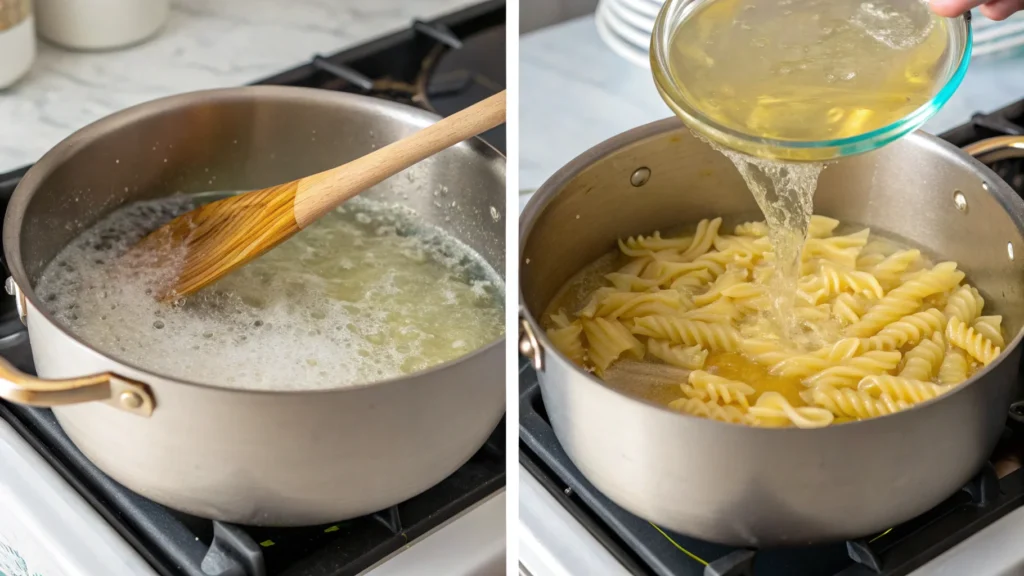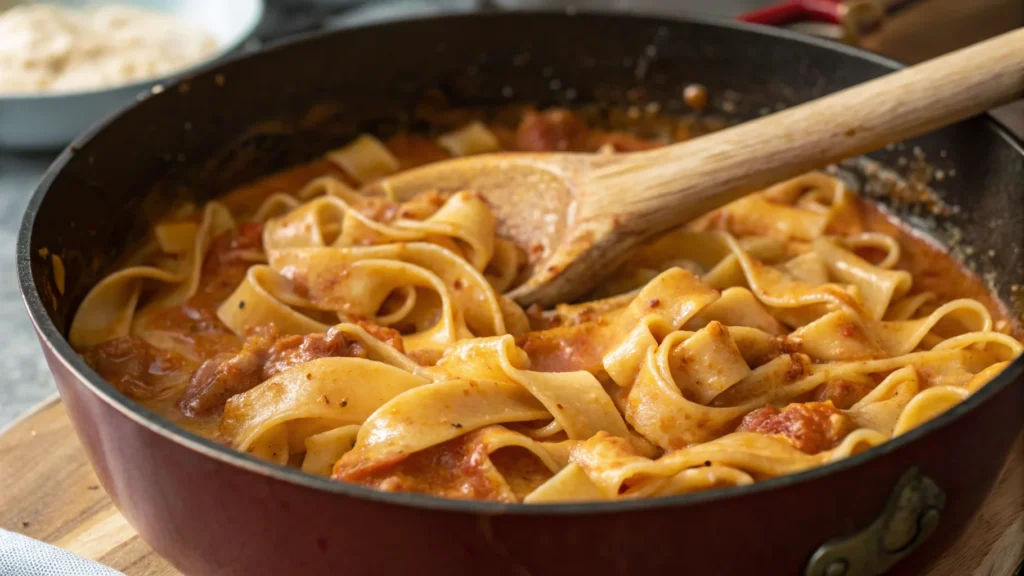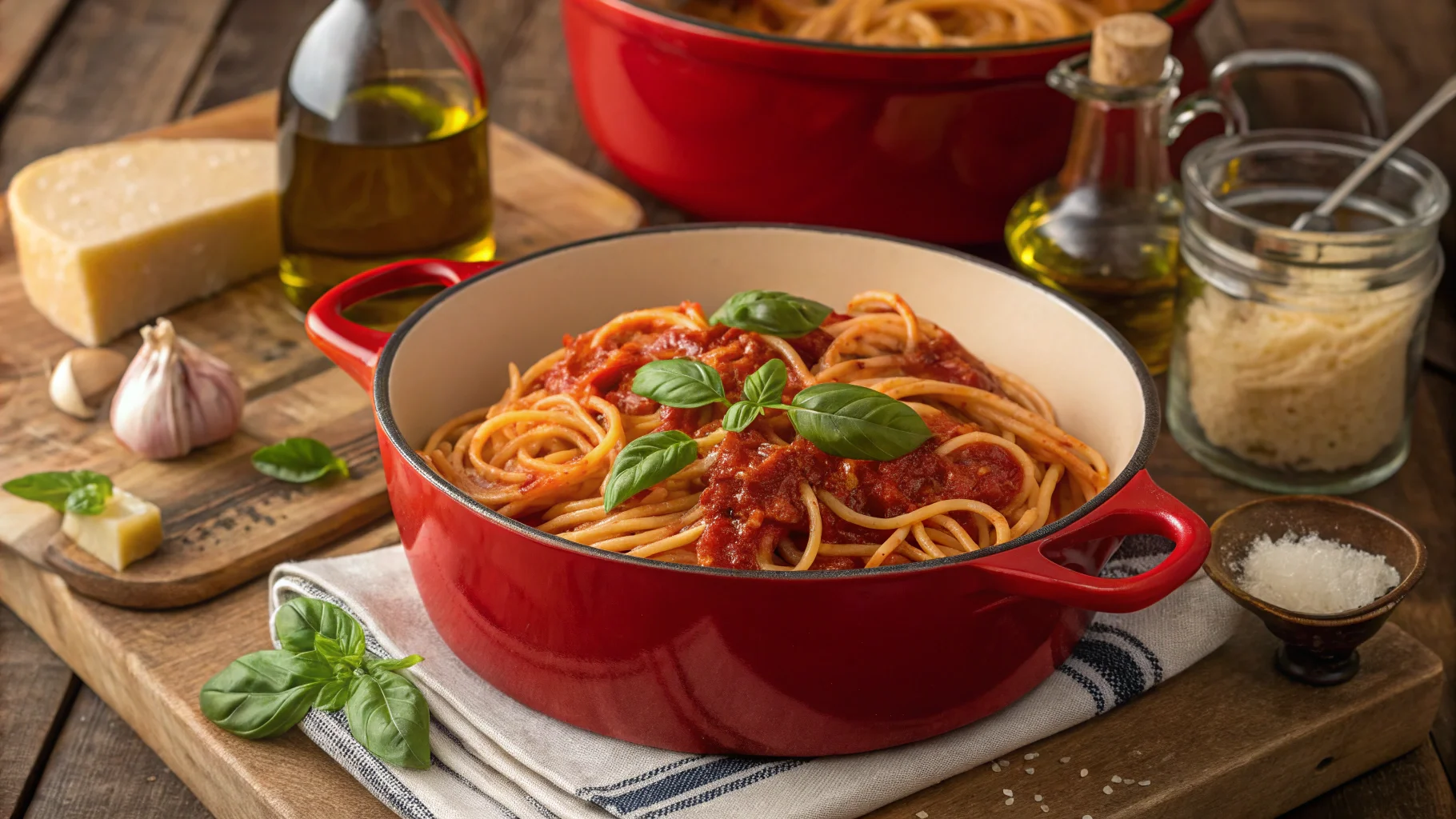Cooking pasta in a Dutch oven is a game-changer for its convenience and versatility, but it’s not without its challenges. One common problem? The pasta sticking to the pot! If you’ve ever found yourself asking, “How do you keep pasta from sticking to a Dutch oven?”, this article has you covered. From understanding why sticking happens to providing practical tips for prevention, we’ll walk you through everything you need to know to make your pasta-cooking experience seamless. Let’s dive in!
Understanding Why Pasta Sticks to a Dutch Oven
Common Reasons for Sticking
Pasta sticking to a Dutch oven can be frustrating, but it often happens due to a few simple factors. One major culprit is inadequate stirring. When pasta sits too long in one spot, its starches start to release and stick to the pot’s surface. Another common issue is using too little water. Without enough liquid, pasta doesn’t have the room it needs to move freely, increasing the chances of clumping and sticking.
Additionally, the timing of your salt matters. Adding salt before the water boils can slightly alter the surface of your pot, increasing the likelihood of pasta sticking. Lastly, starting with cold water instead of boiling water can cause the noodles to adhere to the pot’s surface as the starches activate prematurely.
The Role of the Dutch Oven’s Material and Condition
The type and condition of your Dutch oven also play a big role. Enameled Dutch ovens are less likely to cause sticking due to their smooth surface, whereas raw cast iron can sometimes grab onto food if it’s not properly seasoned. If the enamel coating is worn or scratched, you might notice sticking more often. Regular care and maintenance of your Dutch oven can help mitigate these issues.
Understanding why sticking happens is the first step to solving it. In the next sections, we’ll explore how to prep your Dutch oven and what to do during cooking to keep things from sticking. Stay tuned!
Preparing Your Dutch Oven to Prevent Sticking
Seasoning a Cast Iron Dutch Oven for Better Performance
If you’re using a raw cast iron Dutch oven, proper seasoning is key to preventing pasta from sticking. Seasoning creates a non-stick layer by baking oil into the pores of the cast iron. To do this, apply a thin layer of vegetable oil or flaxseed oil to the pot’s interior, then bake it in the oven at 400°F for about an hour. This process not only enhances the surface but also protects the pot from rust.
Even if you don’t use your Dutch oven frequently, it’s good to re-season it every few months to maintain its effectiveness. While enameled Dutch ovens don’t require seasoning, keeping their surface smooth and clean is equally important to minimize sticking.
Choosing the Right Dutch Oven: Enameled vs. Non-Enameled
When it comes to choosing between enameled and raw cast iron Dutch ovens, both have their pros and cons. Enameled Dutch ovens are a great choice if you’re wondering, “How do you keep pasta from sticking to a Dutch oven?” because their smooth, coated surface naturally prevents food from clinging.
On the other hand, traditional cast iron Dutch ovens can be just as effective with proper care and seasoning. If you already own a raw cast iron pot, consider adding a layer of oil to the water before cooking pasta to create an additional barrier. Regardless of the type, a well-maintained Dutch oven is your best friend for cooking pasta without frustration.
Preparing your Dutch oven ahead of time sets the stage for a smooth cooking process. Next, we’ll focus on techniques to use during cooking to further prevent sticking.

Best Practices While Cooking Pasta in a Dutch Oven
Adding Enough Water to Ensure Proper Boiling
One of the simplest ways to prevent pasta from sticking is by using plenty of water. Pasta releases starch as it cooks, and without enough water, this starch becomes concentrated and causes the noodles to stick to each other or the pot. For every pound of pasta, aim to use at least 4 to 5 quarts of water. A Dutch oven’s wide base makes it perfect for boiling pasta evenly, provided you add enough liquid.
Stirring Frequently to Avoid Clumping and Sticking
How do you keep pasta from sticking to a Dutch oven? Stirring frequently is an easy and effective solution. When you first add the pasta to boiling water, stir it immediately to ensure it doesn’t settle at the bottom. After that, stir every few minutes to keep the noodles moving. This prevents clumping and keeps the starches from adhering to the pot’s surface.
Maintaining the Right Heat Levels While Cooking
Managing heat is another critical factor. Keep the water at a rolling boil, but avoid cranking the heat too high, as this can lead to uneven cooking or cause the water to boil over. If you’re cooking a one-pot pasta dish where the noodles are boiled with sauce, reduce the heat to a gentle simmer after the initial boil. This ensures even cooking while preventing the sauce from burning or sticking to the pot.
By following these simple steps, you’ll eliminate most of the common problems associated with cooking pasta in a Dutch oven. Up next, we’ll discuss how to handle the pasta after cooking to keep it from sticking during the saucing and serving process.

How to Avoid Sticking During the Draining and Saucing Process
The Importance of Draining Properly
After boiling your pasta in a Dutch oven, proper draining is essential to avoid sticking. Once the pasta reaches al dente perfection, transfer it quickly to a colander to drain out excess starch and water. Letting the pasta sit in the water for too long after cooking can cause it to clump together and stick, even when it’s later mixed with sauce.
If you want to retain some of the starchy pasta water for your sauce, scoop out a cup before draining. This water acts as a natural thickener and helps the sauce cling better to the pasta without causing sticking issues.
Using Oil or Butter to Coat the Pasta
One trick for preventing sticky pasta is lightly coating it with olive oil or butter immediately after draining. This creates a slick barrier that stops the pasta from drying out or clumping together before it’s added to the sauce. However, be cautious about using too much oil, as it can prevent the sauce from adhering properly.
Incorporating Sauce Immediately to Prevent Drying
To minimize sticking, always toss the pasta in sauce as soon as it’s drained. A Dutch oven makes this step easy since you can prepare your sauce right in the same pot after draining the pasta. The heat from the Dutch oven helps the sauce and pasta combine seamlessly, creating a dish that’s flavorful and perfectly coated.
For more ideas on one-pot pasta recipes, check out Spaghetti and Meatballs in a Dutch Oven.
Cleaning and Maintaining Your Dutch Oven After Cooking
Gentle Cleaning Tips to Preserve the Coating
Cleaning your Dutch oven properly after cooking pasta is crucial to maintaining its non-stick properties. Begin by letting the pot cool completely—pouring cold water into a hot Dutch oven can damage the enamel or seasoning. Once it’s cooled, use warm water and mild dish soap to clean the pot. A soft sponge or non-abrasive brush works best for removing food particles without scratching the surface.
For enameled Dutch ovens, avoid harsh scrubbing pads or cleaners, as these can wear down the coating over time. If stubborn residue remains, soak the pot with warm soapy water for 15–20 minutes before gently scrubbing.
Removing Burnt Residue Without Damaging the Dutch Oven
If you encounter burnt or stuck-on residue, don’t panic. Mix a paste of baking soda and water, then apply it to the affected areas. Let it sit for a few minutes before gently scrubbing with a soft sponge. For extra-stubborn spots, try boiling a mixture of water and baking soda directly in the pot, which loosens the residue without harming the surface.
Proper cleaning ensures your Dutch oven stays in excellent condition, preventing future sticking issues. For more tips, visit this guide on keeping pasta from sticking in your Dutch oven.
Common Mistakes to Avoid When Cooking Pasta in a Dutch Oven
Overcrowding the Pot with Too Much Pasta
One common mistake that leads to sticky pasta is overcrowding the Dutch oven. When you add too much pasta to the pot, there’s not enough space for the water to circulate freely. This prevents the pasta from cooking evenly and increases the likelihood of clumping. To avoid this, use a Dutch oven large enough to accommodate the pasta and water ratio—about 4 to 5 quarts of water per pound of pasta.
Overcrowding can also cause starches to concentrate in the water, which promotes sticking. If you’re cooking for a large group, consider boiling the pasta in batches rather than trying to fit it all into one pot.
Skipping Steps Like Stirring or Adding Salt
Another mistake is skipping essential steps like stirring the pasta regularly. Frequent stirring, especially in the first few minutes of cooking, keeps the pasta from settling at the bottom of the Dutch oven and sticking.
Additionally, forgetting to add salt can lead to bland pasta that doesn’t cook as efficiently. Salt not only enhances flavor but also helps prevent sticking by altering the water’s surface tension. Remember, how do you keep pasta from sticking to a Dutch oven? Stirring and salting your water are non-negotiable steps.
Avoiding these mistakes will make your pasta-cooking process smoother and stick-free.
FAQs from the Web
Do I Need to Oil My Dutch Oven Before Cooking Pasta?
Not necessarily. If you’re boiling pasta in plenty of water, there’s no need to oil the Dutch oven beforehand. However, if you’re making a one-pot pasta recipe where the noodles cook with minimal liquid, adding a splash of olive oil can help prevent sticking. This is especially useful if your Dutch oven has a slightly rough or worn surface.
Can Nonstick Sprays Be Used in a Dutch Oven?
While nonstick sprays might seem like a good idea, they’re generally not recommended for Dutch ovens, especially enameled ones. These sprays can leave a sticky residue over time that’s hard to clean and may damage the enamel coating. Instead, rely on proper maintenance, seasoning (for cast iron), and sufficient water during cooking to prevent sticking naturally.
How Do I Prevent Sticking Without Adding Too Much Oil?
The best way to avoid sticking is to follow a combination of techniques: stir frequently, use enough water, and avoid overcrowding the pot. If you’re draining the pasta and waiting to sauce it, toss the noodles lightly with olive oil to keep them from clumping together. These small steps eliminate the need for excessive oil while ensuring your pasta doesn’t stick.
By addressing these FAQs, you’ll have a clear understanding of how to handle sticking issues. For additional tips, explore this guide on using Dutch ovens for spaghetti.
Conclusion: Making the Most of Your Dutch Oven for Pasta
Recap of Key Tips to Prevent Sticking
Cooking pasta in a Dutch oven can be a rewarding experience when you know how to prevent sticking. From using enough water and stirring frequently to seasoning your cast iron pot or choosing an enameled one, small adjustments make a big difference. Additionally, incorporating sauce right after draining or lightly coating pasta with olive oil can keep everything smooth and delicious.
If you’re still wondering, “How do you keep pasta from sticking to a Dutch oven?”, remember that preparation and proper technique are your best tools. Avoid overcrowding the pot, stick to the right water-to-pasta ratio, and never skip stirring. With these strategies, sticky pasta will be a thing of the past.
Final Thoughts on Dutch Oven Maintenance and Use
To get the most out of your Dutch oven, regular cleaning and maintenance are essential. Proper care not only extends the life of your cookware but also ensures every meal is as good as the last. Whether you’re boiling pasta, making sauce, or creating a one-pot meal, the Dutch oven proves to be an incredibly versatile tool in the kitchen.
For more ideas on how to use your Dutch oven, check out this guide on avoiding sticky pasta or explore spaghetti recipes tailored for Dutch ovens.
FAQs from the Web
Can Pasta Stick Even in a Nonstick Dutch Oven?
Yes, pasta can still stick in a nonstick Dutch oven if proper steps aren’t followed. For example, not using enough water or forgetting to stir regularly can cause pasta to clump together. Nonstick surfaces help, but they’re not a foolproof solution.
What Are the Best Dutch Oven Sizes for Cooking Pasta?
The ideal size depends on how much pasta you’re cooking. For smaller meals, a 4- to 5-quart Dutch oven works well, while larger batches may require a 6- to 8-quart pot. Having enough space ensures the pasta cooks evenly and doesn’t stick together or to the pot.
How Do I Avoid Sticking When Cooking One-Pot Pasta Recipes?
When making one-pot pasta dishes in a Dutch oven, ensure there’s enough liquid to cover the noodles. Stir often as the pasta cooks to keep it moving, and reduce the heat to a simmer once the dish begins to thicken. This method prevents sticking while creating a rich, flavorful sauce.
These FAQs address common sticking issues and provide clear answers to help you confidently cook pasta in your Dutch oven.

